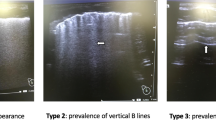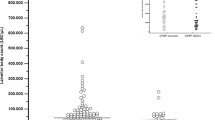Abstract
We determined prospectively if the stable microbubble (SM) test on gastric aspirate obtained at birth was as useful as that on amniotic fluid in predicting respiratory distress syndrome (RDS). One hundred and five paired samples of amniotic fluid obtained at delivery from 105 consecutive women with gestation of 35 weeks or less and gastric aspirates from their neonates obtained within 30 min of birth were studied. The SM test with the predefined cut-off value of less than 5 bubbles/mm2 for amniotic fluid and less than 10 bubbles/mm2 for gastric aspirate signified the risk of RDS with the positive predictive value of 100% and 96% and with the negative predictive value of 91% and 84%, respectively. We conclude that the SM test on both amniotic fluid and gastric aspirate obtained at birth is a rapid (<10 min), simple and reliable procedure for predicting neonates who will develop RDS. It may be used as a bedside test to define a population of neonates with surfactant deficiency in clinical trials of prophylactic surfactant therapy.
Similar content being viewed by others
Abbreviations
- RDS:
-
respiratory distress syndrome
- SM:
-
stable microbubble
- ROC curve:
-
receiver operating characteristic curve
References
Adams FH, Fujiwara T, Emmanouilides G, Raiha N (1970) Lung phospholipid of human fetuses and infants with and without hyaline membrane disease. J Pediatr 77: 833–841
Armitage P (1971) Statistical methods in medical research. Blackwell Scientific Publications, Oxford, pp 127
Barr PA, Jenkins PA, Baum JD (1975) Lecithin/sphingomyelin ratio in hypopharyngeal aspirate of newborn infants. Arch Dis Child 50: 856–861
Blumenfeld TA, Driscoll JM, James LS (1974) Lecithin/sphingomyelin ratios in tracheal and pharyngeal aspirates in respiratory distress syndrome. J Pediatr 85: 403–407
Chida S, Fujiwara T. Stable microbubble test for predicting the risk of respiratory distress syndrome: I. Comparisons with other predictors of fetal lung maturiy in amniotic fluid. Eur J Pediatr 152: 147–150
Chida S, Fujiwara T, Takahashi A, Kanehama S, Kaneko J (1991) Precision and reliability of stable microbubble test as a prediction of respiratory distress syndrome. Acta Paediatr Jpn 33: 15–19
Cowett RM, Unsworth EJ, Hakanson DO, Williams JR, Oh W (1975) Foam-stability test on gastric aspirate and the diagnosis of respiratory-distress syndrome. N Engl J Med 293: 413–416
Evans JJ (1975) Prediction of respiratory-distress syndrome by shake test on newborn gastric aspirate. N Engl J Med 292: 1113–1115
Farrell PM, Avery ME (1975) Hyaline membrane disease. Am Rev Respir Dis 111: 657–688
Freedman LS (1987) Evaluating and comparing imaging techniques: a review and classification of study designs. Br J Radiology 60: 1071–1081
Fujiwara T, Adams FH (1968) Incorporation of labeled palmitate into “alveolar” and whole lung phospholipids of fetal and newborn lambs. Proc Soc Exp Biol Med 128: 88–93
Fujiwara T, Takahashi H (1989) Assessment of fetal lung maturity: stable microbubble test in amniotic fluid and gastric aspirate. J Jpn Med Assoc 101: 281–288 (in Japanese)
Fujiwara T, Adams FH, Sipos S, El-Salawy A (1968) “Alveolar” and whole lung phospholipids of the developing fetal lamb lung. Am J Physiol 215: 375–382
Fujiwara T, Konishi M, Chida S, Okuyama K, Ogawa Y, Takeuchi Y, Nishida H, Kito H, Fujimura M, Nakamura H, Hashimoto T (1990) Surfactant replacement therapy with a single postventilatory dose of a reconstituted bovine surfactant in preterm neonates with respiratory distress syndrome: final analysis of a multicenter, double-blind, randomized trial and comparison with similar trials. Pediatrics 86: 753–764
Gluck L, Motoyama EK, Smits HL, Kulovich MV (1967) The biochemical development of surface activity in mammalian lung. I. The surface-active phospholipids; the separation and distribution of surface-active lecithin in the lung of the developing rabbit fetus. Pediatr Res 1: 237–246
Ikegami M, Jacobs H, Jobe A (1983) Surfactant function in respiratory distress syndrome. J Pediatr 102: 443–447
Jobe AH, Ikegami M, Jacobs HC, Jones AJ (1983) Surfactant pool sizes and severity of respiratory distress syndrome in prematurely delivered lambs. Am Rev Respir Dis 127: 751–755
Konishi M, Fujiwara T, Naito T, Takeuchi Y, Ogawa Y, Inukai K, Fujimura M, Nakamura H, Hashimoto T (1988) Surfactant replacement therapy in neonatal respiratory distress syndrome: a multi-center, randomized clinical trial: comparison of high-versus low-dose of Surfactant TA. Eur J Pediatr 147: 20–25
Mattox HE, MacKenna J, Hodson CA, Wimmer JE, Brame RG (1984) Comparison of pharyngeal aspirate and amniotic fluid surfactant composition. Am J Obstet Gynecol 150: 132–135
McClure G, Hicks E, Greene E, Reid M (1975) Gastric aspirate lecithin/sphingomyelin ratio. Lancet II: 1155
Pattle RE, Kratzing CC, Parkinson CE, Graves L, Robertson RD, Robards GJ, Currie JO, Parsons JH, Sutherland PD (1979) Maturity of fetal lungs tested by production of stable microbubbles in amniotic fluid. Br J Obstet Gynaecol 86: 615–622
Platzker ACG, Kitterman JA, Mescher EJ, Clements JA, Tooley WH (1975) Surfactant in the lung and tracheal fluid of the fetal lamb and acceleration of its appearance by dexamethason. Pediatrics 56: 554–561
Smith CA, Nelson NM (1976) The physiology of the newborn infant, 4th edn. Charles C Thomas Publisher, Springfield, pp 469
Stevens PA, Wright JR, Clements JA (1989) Surfactant secretion and clearance in the newborn. J Appl Physiol 67: 1597–1605
Weller PH, Jenkins PA, Gupta J, Baum JD (1976) Pharyngeal lecithin/sphingomyelin ratios in newborn infants. Lancet I: 12–14
Author information
Authors and Affiliations
Rights and permissions
About this article
Cite this article
Chida, S., Fujiwara, T., Konishi, M. et al. Stable microbubble test for predicting the risk of respiratory distress syndrome: II. Prospective evaluation of the test on amniotic fluid and gastric aspirate. Eur J Pediatr 152, 152–156 (1993). https://doi.org/10.1007/BF02072494
Received:
Accepted:
Issue Date:
DOI: https://doi.org/10.1007/BF02072494




